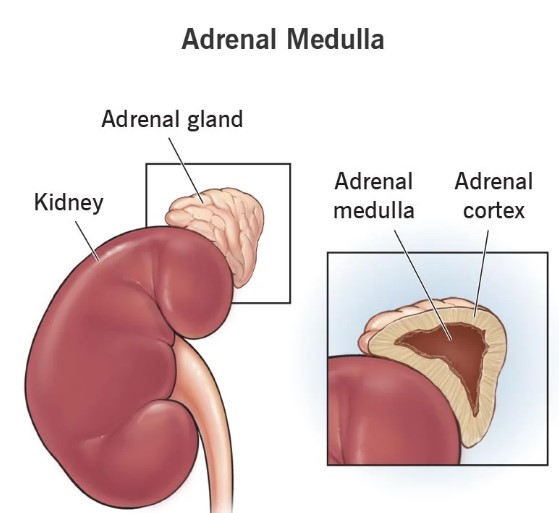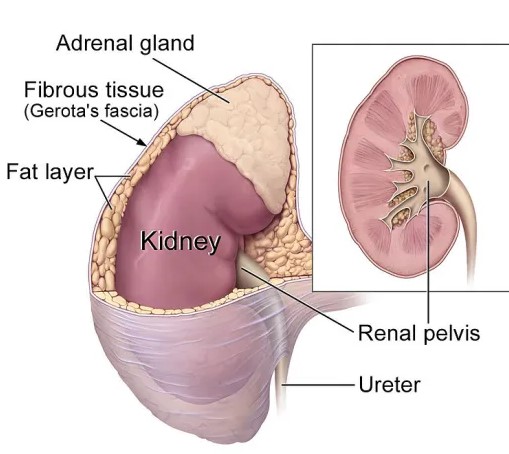The adrenal glands, small yet mighty, play a crucial role in how our bodies respond to stress and regulate essential functions. Nestled atop each kidney, these glands are comprised of two distinct parts: the adrenal cortex and the adrenal medulla. Each has its unique structure, hormones, and roles, affecting everything from our metabolism to our fight or flight response.
The adrenal cortex is responsible for producing steroid hormones such as cortisol and aldosterone, which regulate metabolism, immune response, and blood pressure. In contrast, the adrenal medulla secretes catecholamines, including adrenaline and noradrenaline, which prepare the body for immediate physical action. Understanding the differences between these two sections is key to appreciating how our bodies manage stress and maintain balance.
The adrenal cortex and medulla, while both integral to the adrenal glands’ function, serve distinctly different purposes. The cortex focuses on the body’s long-term stress response, metabolism, and blood pressure regulation, while the medulla is involved in the immediate stress response, increasing heart rate and blood pressure in moments of acute stress. This division of labor ensures that our bodies can effectively respond to a wide range of challenges, from enduring stressors to immediate threats.

Adrenal Glands 101
Anatomy and Location
The adrenal glands are triangular-shaped organs that rest on top of the kidneys. Each gland is composed of two main parts: the adrenal cortex and the adrenal medulla, which differ in structure and function. Despite their small size, these glands are critical in the body’s endocrine system, influencing how we respond to stress and helping to regulate metabolism, immune function, and blood pressure.
Structural Overview
The adrenal glands are encased in a fatty layer that provides protection and support. The outer part, the adrenal cortex, is responsible for producing steroid hormones. In contrast, the inner part, the adrenal medulla, produces catecholamines. This division is not just physical but also functional, with each section playing a unique role in the body’s response to different stimuli.
Functions Overview
General Functions of Adrenal Glands
The adrenal glands are key players in the endocrine system, involved in:
- Regulating metabolism
- Controlling blood pressure
- Responding to stress
- Modulating the immune system
Their hormones impact nearly every organ and tissue, showcasing the glands’ wide-reaching influence on overall health and well-being.
Role in the Endocrine System
The adrenal glands contribute to the endocrine system by producing hormones that communicate with other organs and glands, coordinating a range of bodily functions. This hormonal output is essential for maintaining balance and responding to internal and external changes.
Adrenal Cortex
Structure and Layers
The adrenal cortex is divided into three distinct layers, each producing different hormones:
- Zona glomerulosa: The outermost layer, responsible for aldosterone production.
- Zona fasciculata: The middle layer, primarily producing cortisol.
- Zona reticularis: The innermost layer, which secretes androgens.
Hormones Produced
Corticosteroids: Cortisol and Aldosterone
- Cortisol helps manage stress, regulate metabolism, and influence immune response.
- Aldosterone plays a key role in regulating blood pressure by managing sodium and potassium levels.
Androgens
The adrenal cortex also produces a small amount of androgens, contributing to sex hormone balance.
Functions
The adrenal cortex is vital for:
- Regulating metabolism: Cortisol influences how the body uses carbohydrates, fats, and proteins.
- Stress response: It helps the body to adapt to stress, altering metabolism and immune responses as needed.
- Blood pressure regulation: Aldosterone maintains blood volume and pressure.
- Immune system modulation: Cortisol has anti-inflammatory effects and can suppress the immune system.
Adrenal Medulla
Structure
The adrenal medulla, sitting at the core of the adrenal gland, contrasts with the cortex in both structure and function. It consists mainly of chromaffin cells that synthesize and release catecholamines directly into the bloodstream.
Hormones Produced
Adrenaline (Epinephrine) and Noradrenaline (Norepinephrine)
- Adrenaline increases heart rate, expands air passages, and redistributes blood to muscles, preparing the body for action.
- Noradrenaline also aids in the body’s fight or flight response, complementing adrenaline in its effects.
Functions
The adrenal medulla’s primary role is to prepare the body for quick responses to stress through:
- Fight or flight response: Triggering immediate physical readiness.
- Heart rate and blood pressure: Increasing both to supply more oxygen and nutrients to vital organs and muscles.
- Metabolic activities: Boosting metabolism to provide energy rapidly.
Key Differences Between Adrenal Cortex and Adrenal Medulla
The adrenal glands, while small in size, play a massive role in maintaining our body’s homeostasis. They consist of two main parts: the adrenal cortex and the adrenal medulla, each distinct in structure, function, and the hormones they produce. Understanding these differences is crucial for grasping how our bodies respond to stress and regulate various metabolic processes.
Hormonal Output
Steroid vs. Catecholamines
The adrenal cortex produces steroid hormones, such as cortisol and aldosterone, which have widespread effects on metabolism, immune function, and fluid balance. In contrast, the adrenal medulla secretes catecholamines, including adrenaline and noradrenaline, which are crucial for the body’s immediate stress response.
Functional Role
Long-term Stress vs. Immediate Response
The adrenal cortex is designed for the long-term management of stress, regulating processes like blood pressure and glucose levels over extended periods. The adrenal medulla, on the other hand, kicks into action during immediate stress, preparing the body for a quick reaction through the fight or flight response.
Structural Differences
Layers and Cells
The adrenal cortex is structured into three layers, each producing different types of hormones. The adrenal medulla consists of chromaffin cells that directly release catecholamines into the bloodstream. This structural difference underscores the glands’ distinct roles in hormone production and stress response.
Health Implications
Adrenal Cortex Disorders
Addison’s Disease
Addison’s disease is characterized by the insufficient production of adrenal hormones, particularly cortisol and aldosterone. Symptoms may include fatigue, muscle weakness, weight loss, and low blood pressure.
Cushing’s Syndrome
Contrastingly, Cushing’s syndrome arises from the overproduction of cortisol, leading to symptoms such as weight gain, especially in the face and abdomen, high blood pressure, and skin changes.
Adrenal Medulla Disorders
Pheochromocytoma
Pheochromocytoma is a tumor of the adrenal medulla, causing excessive secretion of catecholamines. This can result in episodes of high blood pressure, severe headaches, palpitations, and sweating.
Management and Treatment
Overview of Treatments for Adrenal Disorders
Treatment strategies for adrenal disorders vary based on the specific condition:
- Addison’s disease typically requires hormone replacement therapy to compensate for the underproduction of adrenal hormones.
- Cushing’s syndrome may involve medication, radiation, surgery, or a combination of these treatments to reduce cortisol levels.
- Pheochromocytoma often requires surgical removal of the tumor, alongside medication to manage symptoms before and after surgery.
Importance of Early Diagnosis
Early diagnosis and treatment of adrenal disorders are crucial for preventing complications and improving quality of life. Regular check-ups, awareness of symptoms, and timely intervention can make a significant difference in managing these conditions effectively.
Frequently Asked Questions
What hormones does the adrenal cortex produce?
The adrenal cortex primarily produces corticosteroids, including cortisol, which regulates metabolism and stress response, and aldosterone, which controls blood pressure. It also secretes a small amount of androgens, contributing to sex hormone balance.
How does the adrenal medulla react to stress?
The adrenal medulla reacts to stress by releasing catecholamines, adrenaline, and noradrenaline. These hormones trigger the body’s fight or flight response, preparing for immediate action by increasing heart rate, blood pressure, and blood glucose levels.
Can disorders affect the adrenal cortex and medulla?
Yes, several disorders can affect the adrenal cortex and medulla. Addison’s disease and Cushing’s syndrome are primarily related to the adrenal cortex, impacting hormone production and leading to various symptoms. Pheochromocytoma, a tumor of the adrenal medulla, causes excessive production of catecholamines, leading to hypertension and other symptoms.
What is the significance of the adrenal glands in regulating blood pressure?
The adrenal glands play a critical role in regulating blood pressure through the production of aldosterone in the cortex, which helps control blood volume and salt levels. Additionally, the catecholamines released by the medulla during stress increase heart rate and blood pressure, further influencing blood pressure regulation.
Conclusion
The adrenal glands, specifically the cortex and medulla, serve essential yet distinct roles in maintaining our body’s equilibrium and response to stress. By producing a variety of hormones, these two parts of the adrenal gland ensure that we can adapt to changing environments, manage stress effectively, and maintain vital functions such as blood pressure regulation and metabolism. Understanding these differences not only highlights the complexity of our endocrine system but also underscores the importance of adrenal health in overall well-being.
As research continues to unravel the intricacies of the adrenal glands, it becomes increasingly clear how vital their proper functioning is to our health. Disorders affecting either the adrenal cortex or medulla can have profound effects, underscoring the need for awareness and timely diagnosis. In this light, the adrenal glands stand out not just as responders to stress but as key players in a wide range of physiological processes critical to our survival and quality of life.

